“Two regions, one grape, and a thousand kilometres of untold connection.”
In the wake of spring, a dream came true for me. Producers from ten wineries of a region in Spain set off to meet producers from ten wineries of a region in France, and I was part of the organization of this event. So what? one might ask. It’s not the first time producers from different regions have got together to taste each other’s wines. Which is true. In fact, I’ve personally organised this type of event on several occasions over the last years. But what made this exchange special was that the Spanish region in question was Jumilla, and the French one Bandol, over 1,000km away. Despite both having a long, ancient history of producing wine and having the rare distinction of growing mostly the Monastrell (aka Mourvèdre) grape variety, their producers have never got together formally to share their experiences of producing wine from this unique Mediterranean grape. In fact, practically none of the producers taking part in the event had ever set foot on the other’s soils.
And so, on March 1st 2025, twenty or so Jumilla producers got up at an unearthly hour to board the bus that would take them, in one go, all the way to Provence in France. As they left the town of Jumilla that morning bleary-eyed, they hardly noticed that the celebrations of the previous night’s local Carnival fiesta were still in full swing in the streets. It was going to be a long ride. Among the party on the bus were winemakers from such established Jumilla wineries as Viña Elena, Bodegas Olivares, Bodegas Juan Gil, Bodegas Carchelo, Pio del Ramo, Casa de la Ermita, Bodegas Silvano Garcia, as well as members of 3 cooperatives (BSI, Bodegas San Dionisio and Bodegas Santiago Apostol).
As they headed towards the French border at La Jonquera, there were many questions in their minds about the region to which they were heading. What similarities were there between the two terroirs? After all, Bandol is on the coast, Jumilla an hour’s drive inland. What challenges do the two regions share? Increasingly scarce rainfall maybe? What rules does Bandol have regarding ungrafted vines (of which there are so many in Jumilla) or the blending of other grape varieties with Monastrell? What obligations do Bandol producers have to comply with in their winemaking? Which rootstocks do they prefer in the current climate? How do they manage water deficit stress in the vineyard? Above all, what can they learn from Bandol, and what can Bandol learn from them?
Very enjoyable with food, they seemed the ideal wine, ironically, to accompany the rice dishes of Jumilla or gazpachos jumillano
No sooner had the bus arrived at their hotel in Bandol than a first tasting was awaiting them in the hotel lounge: a Bandol rosé. This proved to be a particularly apt introduction to the appellation, since rosé wine, of which Monastrell is required to make up at least 20% in the blend, represents the largest proportion of Bandol sales. And fascinatingly, the profile of Bandol rosé is very distinct from the rosé wines made in Jumilla. While Jumilla’s are typically fresh, crisp, vibrant and fruity and enjoyed soon after bottling, Bandol rosés display an onion peel colour and offer delicate floral aromas and softness on the palate. Sometimes aged in oak, they are often consumed after several years in bottle. They are possibly the most famous rosés in France. Very enjoyable with food, they seemed the ideal wine, ironically, to accompany the rice dishes of Jumilla or gazpachos jumillanos with its ingredients of rabbit or snails.
Once the reds were served during the ensuing dinner, the Jumilla producers found themselves on more familiar ground. Produced from at least 50% Monastrell and always blended with another grape variety, however small the percentage, the Bandol reds were structured and complex, offering red and black fruits against a backdrop of liquorice and spices. These wines were built to age a long time and benefited from an hour or so of decanting beforehand.
Bandol red has preserved its identity as a structured, powerful wine to keep for a few years for a special occasion.
But where were the delicious fresh, fruit-driven Monastrell reds so easily found in tapas bars back in Jumilla? The simple answer is that in Bandol, because the reds have to be aged for at least 18 months in oak, wines of that profile don’t exist. Unless of course, a producer wants to make a wine under a different appellation, which some of them do. Whatever your opinion, there’s no disputing the fact that by maintaining these strict ageing rules, Bandol red has preserved its identity as a structured, powerful wine to keep for a few years for a special occasion.
An intensive programme was organised for the following day, during which the producers of both appellations came together at the Bandol Wine Council to taste each other’s wines. Welcomed by the Bandol Council’s president Cédric Gravier, the group was given a brief introduction to the Bandol appellation by director Olivier Colombano. Of particular note to the Jumillanos present, was Bandol’s comparatively small compact surface area (1,600 hectares) and its location in a unique landscape: an amphitheatre looking out over the Mediterranean Sea. Jumilla, by contrast, offered a far greater diversity of altitudes, climatic influences, exposures and soils. While Bandol could be visited comfortably in a couple of days, the return visit to Jumilla by Bandol producers might require a full week to appreciate the rich diversity of Jumilla’s terroir.
After a lively discussion about the Bandol vineyard and winemaking trends, it was time to present Jumilla and the ten wineries that had travelled to the event. With the aid of a Power Point presentation, the Bandol producers were given a glimpse of the special character of the Jumilla vineyards and soils. With its altitudes ranging from 350m to 1,000m and vast horizons interspersed by mountain ranges, the Jumilla landscape immediately caught the imagination of the Bandol growers, who were clearly eager to taste the wines and discover the different expressions of Monastrell in types of terroir they did not have in Bandol.
With styles ranging from the more traditional to the more contemporary versions of Monastrell, there was something to suit each person’s taste.
The presentation was followed by a tasting of twenty Jumilla wines, two chosen by each Jumilla winery taking part. Since Jumilla reds represent the lion’s share of the Jumilla appellation’s production, the main focus was on these, with each winery typically presenting an entry-level/middle range red, alongside a premium red. The Bandol tasters were delighted to also discover other Jumilla wine types, such as a fresh, fruity mineral white blend of Muscat and Chardonnay produced by Pio del Ramo and two Dulce Monastrell sweet reds, produced by Bodegas Olivares and Bodegas Silvano Garcia, which proved hugely popular. Within the space of a couple of hours, the Bandol producers had completed a tasting journey from the more Mediterranean-influenced lowlands to the cool, Continental-climate, high altitude slopes of Albacete province. With styles ranging from the more traditional to the more contemporary versions of Monastrell, there was something to suit each person’s taste.
A buffet lunch was then laid on by the Bandol Wine Council, during which it was Bandol’s turn to showcase their own wines. Whites, rosés and reds accompanied local Provençal dishes together with olives, ham, almonds and delicious fig cake especially brought up from Jumilla for the occasion by the Jumilla Council.
While the Monastrell grape provided a common thread in the morning session, the profiles and styles of the wines varied. It was appropriate then that during the rest of the programme the Jumilla producers would be welcomed into the intimacy of some of the Bandol wineries to get to know the philosophy of individual wine growers. After a relaxing postprandial stroll around the medieval village of Le Castellet, the Jumilla producers were taken to one of Bandol’s legendary wine estates: Château Pibarnon. As the bus wended its way up the slopes leading to the wine estate, Eric de Saint Victor, its charismatic owner and director, was waiting half-way up the climb to accompany the bus to the top of the amphitheatre, where his cellars look out over the valley to the Mediterranean Sea.
And as the shadows lengthened in the Mediterranean sun, the group clambered down to the château and winery for a tour of the cellars, crammed full of foudres of various shapes and sizes
Here the Jumilla producers got the chance to see some Bandol Monastrell vines at first hand and observe the ancient limestone rock formations over which the Pibarnon vines are grown. Stopping at a newly replanted plot of Monastrell, the Jumilla viticulturalists in the group exchanged views on grafting techniques, using twigs picked up from the ground to demonstrate to Eric that ancient craft as it is practised in Jumilla. And as the shadows lengthened in the Mediterranean sun, the group clambered down to the château and winery for a tour of the cellars, crammed full of foudres of various shapes and sizes. Eric, accompanied by winemaker Marie Laroze, then rounded off the tour with a stunning tasting of rosés and reds going back a couple of decades.
As each of the visitors expressed their particular preference among the many fascinating wines tasted, it was becoming clear that Bandol and Jumilla were as different as they were similar. As Eric put it so succinctly, “we are not the same, but we’re riding the same horse” -an obvious reference to the grape variety that both regions share and love. Could it be however, that after the many changes it has gone through over the years, Jumilla is in some ways edging closer to the Bandol philosophy of making elegant and complex wines capable of long ageing? And might it also be that Bandol, with its stubborn refusal to allow monovarietal Monastrell wines and its inflexible rules about oak ageing times, is beginning to wonder if their appellation should be offering a more complete range of red wines, including vibrant, seductive reds, such as can be found in Jumilla? Only time will tell.
The day was completed with a stroll along Bandol’s charming seafront and a dinner at “De la Terre au Vin”, a bistro specialising in the wines of the region. Owner and wine enthusiast Nicolas had carefully prepared a range of dishes to accompany some of the alternative boutique wines he’d personally selected from around the region. It had been an intensive day during which the main protagonist, Monastrell, had never left centre stage.
The next and final day began with a visit to a Bandol wine cooperative. Surprisingly for a small appellation, Bandol has 3 cooperatives. The educational journey to this appellation surely wouldn’t have been complete without getting the views of local grape producers and the cooperative winemakers whose job it is to supply the market with reasonably-priced wines to satisfy the everyday consumer.
The Jumilla producers were warmly welcomed at the Cave de la Cadiérenne by its president Pascal Coureit
The Jumilla producers were warmly welcomed at the Cave de la Cadiérenne by its president Pascal Coureit and given a tour of this traditional Bandol cooperative. With a well-situated wine shop next to the entrance to the winery offering a wide range of wines, the cooperative benefits from the many thirsty summer tourists that frequently pop in during their holidays in this famous part of France. For holidaymakers, rosé is clearly a big favourite on hot summer days, and the range on offer in the shop clearly caters for these consumers.
One wondered how easy it was for a cooperative to sell Bandol reds, which are required to be aged either in foudres or larger format barrels for at least 18 months. La Cave Cadiérenne had nevertheless succeeded in producing an attractive, reasonably-priced Bandol red. However, it seemed that the Cave’s unoaked rosé was more popular with everyday consumers. Bandol’s top-end reds clearly belonged in a niche market.
Thanks to the Cave, the Jumilla producers had been able to compare and contrast the realities of grape production and market demand in Bandol with their own. Now, pour finir en beauté, it was time to visit Bandol’s other iconic winery: Domaine Tempier. Just a 5-minute drive away from the cooperative, this charming family estate is run by Daniel Ravier, a humble, gentlemanly figure who has a passionate belief in Monastrell and its capacity to produce long-ageing, balanced and elegant wines.
After a detailed technical presentation of the vineyard, during which Daniel confessed that he intended to pay a visit to Jumilla soon to buy vine plants to trial in his vineyards, he took the group down to his ageing cellar, where the only barrique in the room was stood on its end to place bottles on for the tasting. Elsewhere, of course, the cellar was filled with foudres of different capacities and from coopers of different nationalities.
A delicious lunch was enjoyed accompanied by magnums of stunning old vintages of Bandol red and even a rosé, the colour of which had become almost golden.
After an explanation of how climatic conditions had impacted the profiles of the different vintages the group tasted, it was time for everyone to take a seat at a long elegant table stretching along the château’s façade. A delicious lunch was enjoyed accompanied by magnums of stunning old vintages of Bandol red and even a rosé, the colour of which had become almost golden.
Joining the group for lunch was Tempier’s vineyard manager, Jean-Philippe Fourney. It was only at the end of the lunch that it was revealed that the rosé the group had so much enjoyed when they first arrived at their hotel in Bandol a couple of days earlier, had been produced by Jean-Philippe, from his own small estate, Domaine de Baravéou, which he runs in his free time. Fittingly, the trip had been brought full circle. The Jumilla producers said their farewells and reluctantly boarded their bus which, a few minutes later, would be heading back towards Barcelona and onwards to their own treasured Monastrell vineyards.

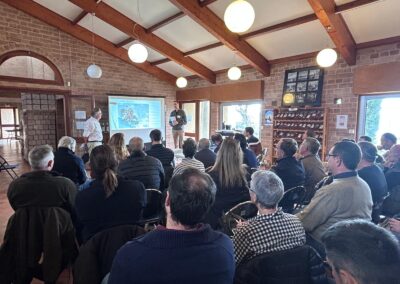

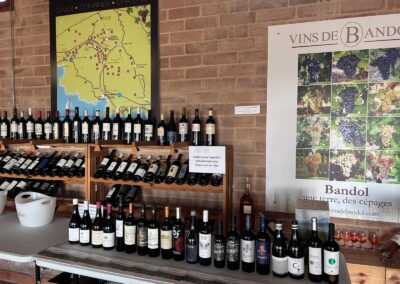
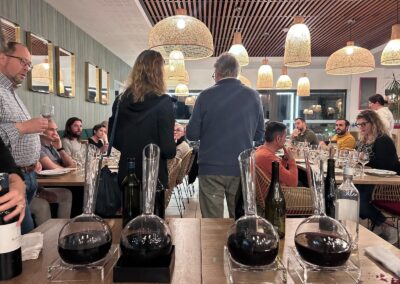

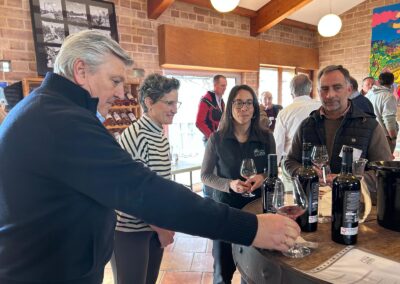
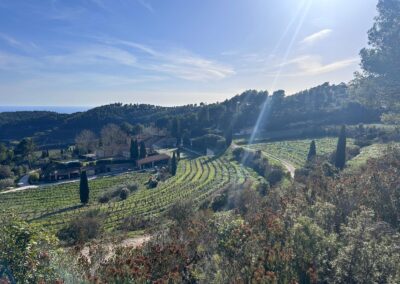
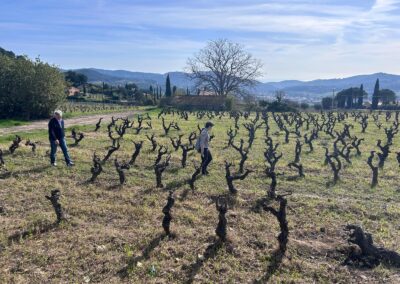
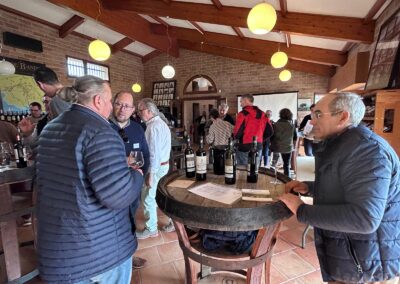

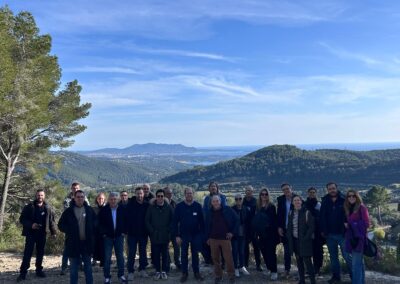


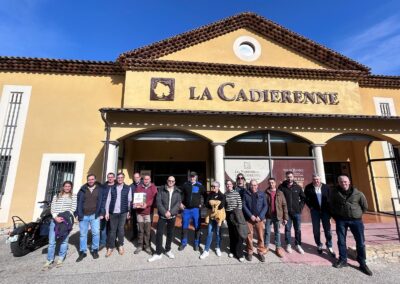
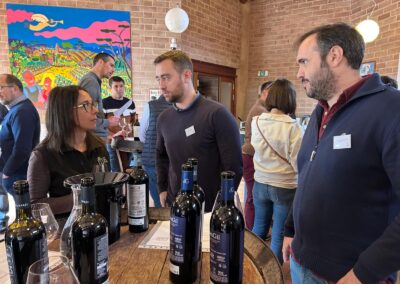
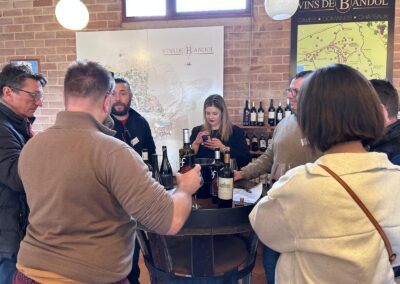


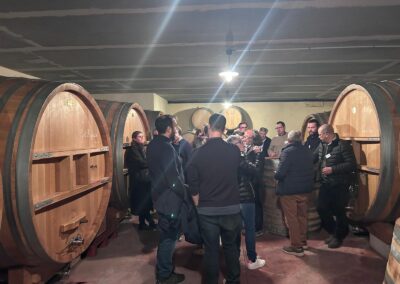
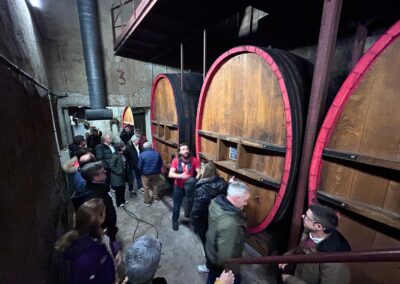

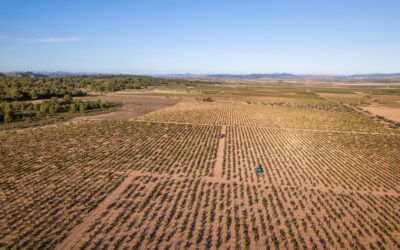


0 Comments